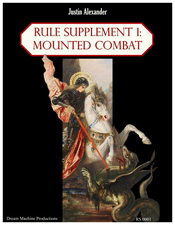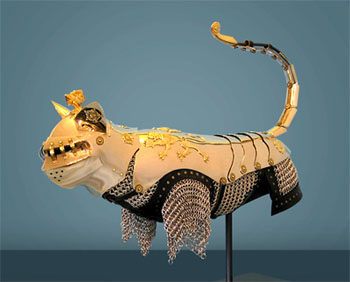RPGNow – Lulu PDF – Print Edition
 I had a conversation this afternoon that reminded me of something I meant to talk about many moons ago regarding the development of Rule Supplement 1: Mounted Combat.
I had a conversation this afternoon that reminded me of something I meant to talk about many moons ago regarding the development of Rule Supplement 1: Mounted Combat.
Here’s the question that jogged my memory: “Is a familiar proficient in the same armor as the caster?”
This, it turns out, is not an easy question to answer. It ends up falling into the middle of several rather murky portions of the rules. The Animal type in the SRD reads: “Proficient with no armor unless trained for war.”
The first complication with this is that familiars aren’t actually Animals, they’re Magical Beasts. And the Magical Beast type simply reads: “Proficient with no armor.” So what happens if you take a war-trained animal and make it a familiar? Does it simply lose the proficiency?
The answer to that is: Maybe. The rules for familiars read, “A familiar is a normal animal that gains new powers and becomes a magical beast when summoned to service by a sorcerer or wiard. It retains the appearance, Hit Dice, base attack bonus, base save bonuses, skills, and feats of the normal animal it once was, but it is treated as a magical beast instead of an animal for the purpose of any effect that depends on its type. Only a normal, unmodified animal may become a familiar.”
You’ll note that proficiencies are not listed in the list of things that the familiar retains when it becomes a magical beast. But, on the other hand, proficiencies can also be a type of feat — should all proficiencies be grouped under that catch-all? I’d certainly argue that this interpretation of the passage makes the most sense.
But the passage also says that “only a normal, unmodified animal” can become a familiar. Is a war-trained animal a “normal, unmodified animal”?
Good question. What is a war-trained animal?
And here we come to the second murky area of the question: The term “war-trained” is never actually defined in the rulebook. The term is used in the Animal type (quoted above) and in a few scattered references to warhorses vs. normal horses, but it’s never explained. You would think since it involves training an animal that it would be referenced in the Handle Animal skill… but no such luck.
This was an issue that I needed to resolve for Rule Supplement 1: Mounted Combat. The way I resolved this issue was to create the War-Trained animal purpose. Animals could be trained with this purpose using the Handle Animal skill:
War-trained (DC 20): A war-trained animal knows the tricks attack, come, defend, down, guard, and heel. War-training an animal takes six weeks. You may also “upgrade” an animal trained for riding to a war-training by spending three weeks and making a successful DC 20 Handle Animal check. The new general purpose replaces the animal’s previous purpose. A war-trained animal is proficient with all armors (light, medium, and heavy) and shields (including tower shields).
Problem solved. If you adopt this War-Trained animal purpose as a fix-it for the oversight in the core rulebooks, then I don’t think it’s too much of a leap to allow a familiar to be war-trained (even though they’re technically magical beasts and not animals).
However, the may not be necessary if you’re willing to make a sufficiently liberal interpretation of the rules for familiar. Those rules state that familiars gain the skill ranks and save bonuses of their masters. Proficiencies aren’t mentioned, but that’s likely because (a) standard familiars can’t use weapons and (b) sorcerers and wizards aren’t proficient in any armor. I don’t think it’s too much of a stretch to allow for the familiar to gain the armor and weapon proficiencies of their master.
After all, it allows for awesome things like this:
And awesome should always win out in the end.













“And here we come to the second murky area of the question: The term “war-trained” is never actually defined in the rulebook. The term is used in the Animal type (quoted above) and in a few scattered references to warhorses vs. normal horses, but it’s never explained. You would think since it involves training an animal that it would be referenced in the Handle Animal skill… but no such luck.”
I think you’re overlooking the obvious (in the Handle Animal skill):
Fighting (DC 20): An animal trained to engage in combat knows the tricks attack, down, and stay. Training an animal for fighting takes three weeks.
While “fighting” isn’t the exact same terminology as “war-trained,” the description “trained to engage in combat” makes it pretty clear that they mean the same thing.
Having grown up as son of a horse trainer, I’d say six weeks is incredibly optimistic for a horse to become war trained to the degree you are suggesting. A three week upgrade time even more so. More like a 3-4 year intensive training program if achievable at all.
You might achieve “doesn’t suddenly dump you on your head as it shies away from scary noises and violent motions in front of it as frequently, +2 or +3 control modifier” with a fully saddle broken horse in 6 weeks, if it has the right disposition. War training has a lot more to do with that than it does with all the fancy tricks. Getting that part down solidly will take awhile. Horses shy suddenly at the damnedest things. It doesn’t have to be people out to kill it, sometimes a blowing leaf or gate flapping in the wind will totally freak an otherwise phlegmatic horse.
Being fully responsive to steering by leg aids and not needing bridle commands so that you have both hands free to fight is the next step, and it takes a serious degree of training for both horse and rider. Doing it in a stressful situation moreso.
Maybe with constant “Charm Animal” and “Talk with Animal” magical support and intervention you could cut it down.
Read Ann Hyland’s “Training the Roman Cavalry, from Arrian’s Ars Tactica” or a 19th C U.S. Army cavalry manual to get a sense of the complexities.